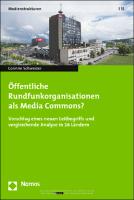Öffentliche Rundfunkorganisationen als Media Commons?
Vorschlag eines neuen Leitbegriffs und vergleichende Analyse in 16 Ländern
| dc.contributor.author | Schweizer, Corinne | |
| dc.date.accessioned | 2021-07-08T11:29:31Z | |
| dc.date.available | 2021-07-08T11:29:31Z | |
| dc.date.issued | 2019 | |
| dc.identifier | ONIX_20210708_9783848760275_130 | |
| dc.identifier | OCN: 1266289784 | |
| dc.identifier.uri | https://library.oapen.org/handle/20.500.12657/49931 | |
| dc.language | German | |
| dc.relation.ispartofseries | Medienstrukturen | |
| dc.subject.classification | thema EDItEUR::K Economics, Finance, Business and Management::KN Industry and industrial studies::KNT Media, entertainment, information and communication industries | en_US |
| dc.subject.other | Öffentlicher Rundfunk | |
| dc.subject.other | Digitales Zeitalter | |
| dc.subject.other | Commons | |
| dc.subject.other | Gemeingut | |
| dc.subject.other | Vergleich | |
| dc.title | Öffentliche Rundfunkorganisationen als Media Commons? | |
| dc.title.alternative | Vorschlag eines neuen Leitbegriffs und vergleichende Analyse in 16 Ländern | |
| dc.type | book | |
| oapen.abstract.otherlanguage | Dieser Band nutzt die durch Elinor Ostrom bekannt gewordene Theorie der Commons – also der Gemeingüter – für eine ganzheitliche Analyse des öffentlichen Rundfunks. Die Autorin argumentiert, dass gesellschaftliche Teilhabe, kollaborative Produktion und offener Zugang zu Inhalten, sowie Abstand zu Markt und Staat, zentral sind für die Legitimation dieser Medienorganisation im digitalen Zeitalter. Sie bespricht drei gegensätzliche Zugänge zur Theorie der Commons und die damit verbundenen «konzeptionellen Stolpersteine», dann schlägt sie 18 Merkmale vor, um Medienorganisationen als «Media Commons» zu analysieren. Anhand einer Dokumentenanalyse untersucht sie 30 öffentliche Rundfunkorganisationen – «übliche Verdächtige» wie ARD, BBC, ORF und SRG, aber auch weniger bekannte Organisationen. Die Autorin kommt zu dem Schluss, dass öffentliche Rundfunkorganisationen zwar einige, aber längst nicht alle Merkmale eines «Media Commons» aufweisen und unterschiedlich nachhaltig funktionieren. This volume uses the theory of the commons, which is often associated with Elinor Ostrom, to conduct a holistic analysis of public service broadcasting. The author argues that social participation, collaborative production and open access to content, as well as distance to markets and the state, are central to the legitimacy of this form of media organisation in the digital age. She discusses three opposing approaches to the theory of the commons and related ‘conceptual stumbling blocks’, and suggests 18 characteristics in order to analyse media organisations as ‘media commons’. By means of a document analysis, she examines 30 public service broadcasting organisations—including ‘the usual suspects’, like ARD, the BBC, ORF or SRG, but also lesser known organisations. She concludes that public service broadcasters feature some, but by no means all, of the characteristics of ‘media commons’ and that they operate with varying degrees of sustainability. | |
| oapen.identifier.doi | 10.5771/9783748901471 | |
| oapen.relation.isPublishedBy | a828cf6c-76dd-4fdb-b400-ec5fba9459b8 | |
| oapen.relation.isFundedBy | 07f61e34-5b96-49f0-9860-c87dd8228f26 | |
| oapen.relation.isbn | 9783848760275 | |
| oapen.collection | Swiss National Science Foundation (SNF) | |
| oapen.series.number | 15 | |
| oapen.place.publication | Baden-Baden | |
| oapen.grant.number | 10BP12_192740 | |
| oapen.grant.program | Open Access Books | |
| oapen.grant.project | Öffentliche Rundfunkorganisationen als Media Commons? Vorschlag eines neuen Leitbegriffs und vergleichende Analyse in 16 Ländern. |

